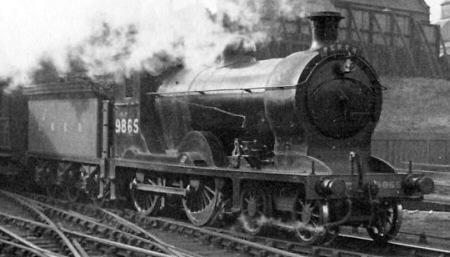The Reid D33 (NBR Class K) 4-4-0 Locomotives

Reid's North British Railway (NBR) D33 locomotives were essentially a mixed-traffic version of his D29 Scott class. The only significant difference, was the use of smaller 6ft diameter driving wheels compared to the D29's 6ft 6in driving wheels. In common with the mixed traffic D32s, the D33s were also known as 'Intermediates' although they had a number of boiler differences and a larger tender.
One batch of twelve D33s were built at Cowlairs in 1909-10. When further engines were required, the superheated D34 Glen had been designed, and these were ordered instead.
The LNER fitted superheaters to the entire class between 1925 and 1936, when the original saturated boilers required replacement. Robinson 22-element superheated Diagram 78 boilers were fitted, and these were interchangeable with the D29 Scott, D30, and D34 Glen classes. Most of the new or rebuilt boilers had Ross pop safety valves fitted, but at least one D33 (No. 9332) retained NBR lock-up safety valves. During the superheating process, the LNER classified the superheated engines as D33/2 whilst the original locomotives became D33/1. After superheating, the D33s resembled the D34 Glens, but they could be distinguished by their Smith outside-admission piston valves located beneath the cylinders.
The D33s were used on similar perishable freight and passenger duties as their D32 predecessors. They tended to be more widely distributed, and could be seen in Aberdeen, Carlisle, Bathgate, Stirling, Thornton, and St. Margaret's, as well as hauling passenger services over the West Highland line.
In 1910, the NBR trialled a number of its 4-4-0 designs against a Highland Railway (HR) 'Castle' Class 4-6-0. NBR D33 No. 867 is reported as outperforming HR No. 146 'Skibo Castle'.
D33 allocations tended to frequently change. A typical allocation during the mid-1930s was: Eastfield (3), Stirling (3), Bathgate (2), Perth (2), Thornton (1), and Hawick (1).
In common with most of the ex-NBR 4-4-0s that survived to World War 2, the D33s were withdrawn after the introduction of large numbers of Thompson B1s. The first two D33s were withdrawn in 1947, and the remaining ten D33s withdrawn before the end of 1953.
Technical Details
The following details refer to the D33s at Grouping (1923). The LNER fitted Diagram 78 boilers with Robinson 22 element superheaters, as fitted to the D29s, D30s, and D34s.
| Cylinders (x2): | (inside) | 19x26in. |
| Motion: | Stephenson | |
| Valves: | 8.75in piston | |
| Boiler: | Max. Diameter: | 5ft |
| Pressure: | 190psi | |
| Diagram No.: | 78 | |
| Heating Surface: | Total: | 1618.12 sq.ft. |
| Firebox: | 139.78 sq.ft. | |
| Tubes: | 1478.34 sq.ft. (258x 1.88in) | |
| Grate Area: | 21.13 sq.ft. | |
| Wheels: | Leading: | 3ft 6in |
| Coupled: | 6ft | |
| Tender: | 4ft 0in | |
| Tractive Effort: | (@ 85% boiler pressure) | 21,053lb |
| Wheelbase: | Total: | 46ft 8.5in |
| Engine: | 23ft 7in | |
| Tender: | 13ft 6in | |
| Weight (full): | Total: | 98 tons 13cwt |
| Engine: | 54 tons 1cwt | |
| Tender: | 44 tons 12cwt | |
| Max. Axle Load: | 19 tons 3cwt |
Preservation
The last D33 was withdrawn in 1953, and none have survived into preservation.
Models
I am not aware of any models of the D33 in any scale.
Acknowledgements
Thank you to David Henderson for the photograph of the superheated D33/2 No. 9695.